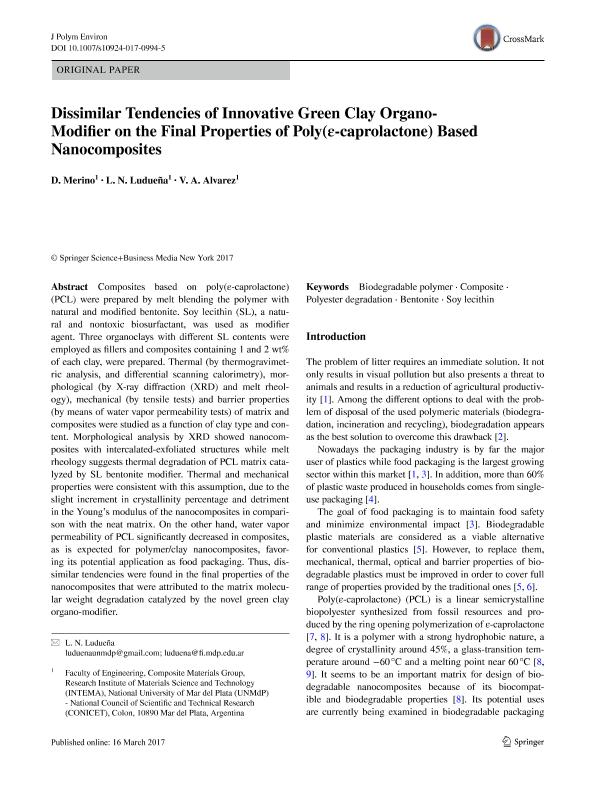Artículo
Dissimilar tendencies of innovative green clay organo-modifier on the final properties of poly(ε-caprolactone) based nanocomposites
Fecha de publicación:
16/03/2017
Editorial:
Springer/plenum Publishers
Revista:
Journal of Polymers and the Environment
ISSN:
1566-2543
e-ISSN:
1572-8900
Idioma:
Inglés
Tipo de recurso:
Artículo publicado
Clasificación temática:
Resumen
Composites based on poly(ε-caprolactone) (PCL) were prepared by melt blending the polymer with natural and modified bentonite. Soy lecithin (SL), a natural and nontoxic biosurfactant, was used as modifier agent. Three organoclays with different SL contents were employed as fillers and composites containing 1 and 2 wt% of each clay, were prepared. Thermal (by thermogravimetric analysis, and differential scanning calorimetry), morphological (by X-ray diffraction (XRD) and melt rheology), mechanical (by tensile tests) and barrier properties (by means of water vapor permeability tests) of matrix and composites were studied as a function of clay type and content. Morphological analysis by XRD showed nanocomposites with intercalated-exfoliated structures while melt rheology suggests thermal degradation of PCL matrix catalyzed by SL bentonite modifier. Thermal and mechanical properties were consistent with this assumption, due to the slight increment in crystallinity percentage and detriment in the Young?s modulus of the nanocomposites in comparison with the neat matrix. On the other hand, water vapor permeability of PCL significantly decreased in composites, as is expected for polymer/clay nanocomposites, favoring its potential application as food packaging. Thus, dissimilar tendencies were found in the final properties of the nanocomposites that were attributed to the matrix molecular weight degradation catalyzed by the novel green clay organo-modifier.
Palabras clave:
Bentonite
,
Biodegradable Polymer
,
Composite
,
Polyester Degradation
,
Soy Lecithin
Archivos asociados
Licencia
Identificadores
Colecciones
Articulos(INTEMA)
Articulos de INST.DE INV.EN CIENCIA Y TECNOL.MATERIALES (I)
Articulos de INST.DE INV.EN CIENCIA Y TECNOL.MATERIALES (I)
Citación
Merino, Danila; Ludueña, Leandro Nicolás; Alvarez, Vera Alejandra; Dissimilar tendencies of innovative green clay organo-modifier on the final properties of poly(ε-caprolactone) based nanocomposites; Springer/plenum Publishers; Journal of Polymers and the Environment; 16-3-2017; 1-12
Compartir
Altmétricas




